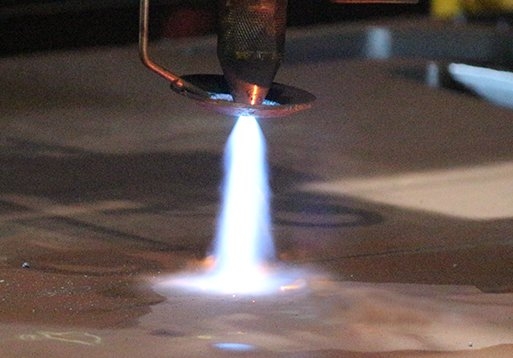What are the different flame cutting techniques?
Flame cutting, also known as oxyfuel cutting, utilises a combination of fuel gas and pure oxygen to cut steels. There are a few different flame cutting techniques, including:
- CNC flame cutting. CNC, or Computer Numerical Control cutting, allows for the precise cutting of complex shapes and forms. This method is well suited to fine and intricate designs, as well as production at large scales.
- Manual flame cutting. This technique requires an expert to manually use a flame cutting torch to cut specified steel shapes.
- Mechanised flame cutting. This approach uses a torch controlled by a machine. The machine is programmed to cut along certain paths and boundaries, providing accurate and precise cuts, particularly for simpler designs and components.
- Plasma cutting. This form of steel cutting uses defined plasma arcs at specific amperage settings to cut steel rapidly and cleanly.
- Carbon arc cutting. This method is suitable for cutting thick materials, particularly those challenging to cut using traditional flame cutting. It makes use of a unique ignitable carbon rod that produces a metal-melting arc.
What equipment and technology are required for flame cutting steel?
The process of flame cutting steel requires a high degree of skill and specialised cutting equipment. Today’s practices also rely increasing on technology to enhance the accuracy and precision of the process.
The most widely used equipment for steel cutting includes a cutting torch. This device mixes fuel gases like acetylene or propane with pure oxygen to produce an exceptionally hot flame. Cutting torches also require gas cylinders that can combine the oxygen and fuel gas used and cutting nozzles that control the temperature and shape of the torch’s flame. Operators need personal protective gear such as protective clothing, heat-resistant gloves, and eye goggles.
Some advanced flame cutting systems make use of sophisticated technologies, which play a vital role in enhancing the speed, precision, and repeatability of cut patterns. Systems like CNC control allow for cutting to be automated using computers. Optical tracing sensors enable these computers to follow templates during the cutting process, thereby improving accuracy and reducing the margin of error involved.
What are the applications of flame cut steel components?
Flame cut steel plate components have a wide range of potential uses across an equally diverse selection of industries. They play particularly important roles in the manufacturing and construction sectors, due to flame cutting’s cost efficiency and suitability for cutting thick metals.
In construction, flame cutting is often used to produce structural components like steel plates, columns and beams. These components are used in the construction of numerous infrastructure projects, including skyscrapers and bridges. The manufacturing industry uses flame cut components to build, repair and maintain industrial and agricultural equipment and other heavy-duty machines.
The mining sector crafts hoppers, chutes, and a range of mining equipment using flame cut components, primarily due to the abrasion resistance and durability of flame cut steels. These components are also widely used in shipbuilding to construct decks and hulls, and in fabrication for the production of custom parts and signage.
Why choose SPS for steel flame cutting services?
We use the latest sophisticated technologies to provide quality, efficient and reliable steel profiling services. Our specialisation in flame cutting enables us to help our clients with projects of all scopes and sizes, and our flame cutting machines use up-to-date CAD software to produce precise profiles according to your exact specifications.
SPS’s steel cutting services are available for plate and sheet metal, carbon steel, and mild steel products in a thickness of up to 200mm. We offer both individual and high-batch runs, as well as additional services like folding, machining, painting and shot-blasting for your convenience.
Steel flame cutting for precision results
Steel flame cutting is a precise and versatile steel cutting method that produces both simple and complex steel components according to exact requirements and dimensions. Our services combine the use of pure oxygen and propane fuels with advanced technology to efficiently produce components that meet strict quality and performance standards.
Contact our team of experts today to learn more about our flame cutting service and determine the best steel cutting solutions for your next project.

